Vegetation Trends Due to Land Cover Changes on the Tibetan Plateau for 2015–2100 Largely Explained by Forest
Abstract
1. Introduction
2. Materials and Methods
2.1. Study Area
2.2. Data Sources and Processing
2.3. Methods
2.3.1. Calculation of Annual and Seasonal NDVI for the Tibetan Plateau During Past Period
2.3.2. Estimation of the Spatiotemporal NDVI Dynamics on the Tibetan Plateau from 2015 to 2100
2.3.3. Quantification of the Contributions of Different Future Land Cover Types on Vegetation Trends in the Tibetan Plateau
3. Results
3.1. Land Cover Dynamics on the Tibetan Plateau from 2015 to 2100 Under Eight Climate Scenarios
3.2. Vegetation Trends Due to Land Cover Changes on the Tibetan Plateau Under Different Climate Scenarios
3.3. Contributions of Land Cover Changes to Annual Vegetation Changess on the Tibetan Plateau Under Different Climate Scenarios
4. Discussion
4.1. Seasonal Impacts of Land Cover Change-Driven Vegetation Trends Under Climate Scenarios
4.2. Seasonal Differences in the Contribution of Land Cover Changes to Vegetation Trends Under Climate Scenarios
4.3. Prospects and Limitations
4.3.1. Impact of Mixed Forests on the Vegetation Trends of the Tibetan Plateau
4.3.2. Implications for Ecological Research on the Tibetan Plateau
4.3.3. Limitations of the Used Data and Methods
5. Conclusions
Author Contributions
Funding
Data Availability Statement
Acknowledgments
Conflicts of Interest
References
- Zhong, L.; Ma, Y.; Xue, Y.; Piao, S. Climate Change Trends and Impacts on Vegetation Greening Over the Tibetan Plateau. J. Geophys. Res. Atmos. 2019, 124, 7540–7552. [Google Scholar] [CrossRef]
- Shen, M.; Piao, S.; Jeong, S.-J.; Zhou, L.; Zeng, Z.; Ciais, P.; Chen, D.; Huang, M.; Jin, C.-S.; Li, L.Z.X.; et al. Evaporative Cooling over the Tibetan Plateau Induced by Vegetation Growth. Proc. Natl. Acad. Sci. USA 2015, 112, 9299–9304. [Google Scholar] [CrossRef]
- Wang, Y.; Xiao, J.; Ma, Y.; Ding, J.; Chen, X.; Ding, Z.; Luo, Y. Persistent and Enhanced Carbon Sequestration Capacity of Alpine Grasslands on Earth’s Third Pole. Sci. Adv. 2023, 9, eade6875. [Google Scholar] [CrossRef] [PubMed]
- Wang, Y.; Ma, Y.; Li, H.; Yuan, L. Carbon and Water Fluxes and Their Coupling in an Alpine Meadow Ecosystem on the Northeastern Tibetan Plateau. Theor. Appl. Climatol. 2020, 142, 1–18. [Google Scholar] [CrossRef]
- Tian, L.; Zhang, Y.; Zhu, J. Decreased Surface Albedo Driven by Denser Vegetation on the Tibetan Plateau. Environ. Res. Lett. 2014, 9, 104001. [Google Scholar] [CrossRef]
- Liu, J.; Lu, Y. How Well Do CMIP6 Models Simulate the Greening of the Tibetan Plateau? Remote Sens. 2022, 14, 4633. [Google Scholar] [CrossRef]
- Zhou, D.; Fan, G.; Huang, R.; Fang, Z.; Liu, Y.; Li, H. Interannual Variability of the Normalized Difference Vegetation Index on the Tibetan Plateau and Its Relationship with Climate Change. Adv. Atmos. Sci. 2007, 24, 474–484. [Google Scholar] [CrossRef]
- Zou, F.; Li, H.; Hu, Q. Responses of Vegetation Greening and Land Surface Temperature Variations to Global Warming on the Qinghai-Tibetan Plateau, 2001–2016. Ecol. Indic. 2020, 119, 106867. [Google Scholar] [CrossRef]
- Huang, Y.; Xin, Z.; Dor-ji, T.; Wang, Y. Tibetan Plateau Greening Driven by Warming-Wetting Climate Change and Ecological Restoration in the 21st Century. Land Degrad. Dev. 2022, 33, 2407–2422. [Google Scholar] [CrossRef]
- Pan, T.; Zou, X.; Liu, Y.; Wu, S.; He, G. Contributions of Climatic and Non-Climatic Drivers to Grassland Variations on the Tibetan Plateau. Ecol. Eng. 2017, 108, 307–317. [Google Scholar] [CrossRef]
- Huang, X.; Zhang, T.; Yi, G.; He, D.; Zhou, X.; Li, J.; Bie, X.; Miao, J. Dynamic Changes of NDVI in the Growing Season of the Tibetan Plateau During the Past 17 Years and Its Response to Climate Change. Int. J. Environ. Res. Public Health 2019, 16, 3452. [Google Scholar] [CrossRef] [PubMed]
- Hua, T.; Wang, X. Temporal and Spatial Variations in the Climate Controls of Vegetation Dynamics on the Tibetan Plateau during 1982–2011. Adv. Atmos. Sci. 2018, 35, 1337–1346. [Google Scholar] [CrossRef]
- Liu, L.; Wang, Y.; Wang, Z.; Li, D.; Zhang, Y.; Qin, D.; Li, S. Elevation-Dependent Decline in Vegetation Greening Rate Driven by Increasing Dryness Based on Three Satellite NDVI Datasets on the Tibetan Plateau. Ecol. Indic. 2019, 107, 105569. [Google Scholar] [CrossRef]
- Zheng, Z.; Zhu, W.; Zhang, Y. Seasonally and Spatially Varied Controls of Climatic Factors on Net Primary Productivity in Alpine Grasslands on the Tibetan Plateau. Glob. Ecol. Conserv. 2020, 21, e00814. [Google Scholar] [CrossRef]
- Dong, Q.-M.; Zhao, X.-Q.; Wu, G.-L.; Shi, J.-J.; Ren, G.-H. A Review of Formation Mechanism and Restoration Measures of “Black-Soil-Type” Degraded Grassland in the Qinghai-Tibetan Plateau. Environ. Earth Sci. 2013, 70, 2359–2370. [Google Scholar] [CrossRef]
- Davidson, A.D.; Detling, J.K.; Brown, J.H. Ecological Roles and Conservation Challenges of Social, Burrowing, Herbivorous Mammals in the World’s Grasslands. Front. Ecol. Environ. 2012, 10, 477–486. [Google Scholar] [CrossRef]
- Cui, X.; Graf, H.-F. Recent Land Cover Changes on the Tibetan Plateau: A Review. Clim. Change 2009, 94, 47–61. [Google Scholar] [CrossRef]
- Wang, C.; Gao, Q.; Yu, M. Quantifying Trends of Land Change in Qinghai-Tibet Plateau during 2001–2015. Remote Sens. 2019, 11, 2435. [Google Scholar] [CrossRef]
- Fan, Z.; Bai, X. Scenarios of Potential Vegetation Distribution in the Different Gradient Zones of Qinghai-Tibet Plateau under Future Climate Change. Sci. Total Environ. 2021, 796, 148918. [Google Scholar] [CrossRef]
- Meng, N.; Yang, Y.; Zheng, H.; Li, R. Climate Change Indirectly Enhances Sandstorm Prevention Services by Altering Ecosystem Patterns on the Qinghai-Tibet Plateau. J. Mt. Sci. 2021, 18, 1711–1724. [Google Scholar] [CrossRef]
- Zhang, R.H.; Su, F.G.; Jiang, Z.H.; Gao, X.J.; Guo, D.L.; Ni, J.; You, Q.L.; Lan, C.; Zhou, B.T. An Overview of Projected Climate and Environmental Changes across the Tibetan Plateau in the 21st Century. Chin. Sci. Bull. 2015, 60, 3036–3047. [Google Scholar]
- Zhao, Q.; Zhu, Z.; Zeng, H.; Zhao, W.; Myneni, R.B. Future Greening of the Earth May Not Be as Large as Previously Predicted. Agric. For. Meteorol. 2020, 292–293, 108111. [Google Scholar] [CrossRef]
- Latif, A.; Ilyas, S.; Zhang, Y.; Xin, Y.; Zhou, L.; Zhou, Q. Review on Global Change Status and Its Impacts on the Tibetan Plateau Environment. J. Plant Ecol. 2019, 12, 917–930. [Google Scholar] [CrossRef]
- Wang, X.; Zheng, D.; Shen, Y. Land Use Change and Its Driving Forces on the Tibetan Plateau during 1990–2000. CATENA 2008, 72, 56–66. [Google Scholar] [CrossRef]
- Pan, Y.; Li, X.; Wang, D.; Li, S.; Wen, L. Impacts of Land Use/Land Cover Distributions on Permafrost Simulations on Tibetan Plateau. Remote Sens. 2023, 15, 5586. [Google Scholar] [CrossRef]
- Wang, F.; Ma, Y.; Darvishzadeh, R.; Han, C. Annual and Seasonal Trends of Vegetation Responses and Feedback to Temperature on the Tibetan Plateau since the 1980s. Remote Sens. 2023, 15, 2475. [Google Scholar] [CrossRef]
- Hou, H.; Zhou, B.-B.; Pei, F.; Hu, G.; Su, Z.; Zeng, Y.; Zhang, H.; Gao, Y.; Luo, M.; Li, X. Future Land Use/Land Cover Change Has Nontrivial and Potentially Dominant Impact on Global Gross Primary Productivity. Earth’s Future 2022, 10, e2021EF002628. [Google Scholar] [CrossRef]
- Van Vuuren, D.P.; Edmonds, J.; Kainuma, M.; Riahi, K.; Thomson, A.; Hibbard, K.; Hurtt, G.C.; Kram, T.; Krey, V.; La-marque, J.-F.; et al. The Representative Concentration Pathways: An Overview. Clim. Change 2011, 109, 5–31. [Google Scholar] [CrossRef]
- O’Neill, B.C.; Tebaldi, C.; Van Vuuren, D.P.; Eyring, V.; Friedlingstein, P.; Hurtt, G.; Knutti, R.; Kriegler, E.; Lamarque, J.-F.; Lowe, J.; et al. The Scenario Model Intercomparison Project (ScenarioMIP) for CMIP6. Geosci. Model Dev. 2016, 9, 3461–3482. [Google Scholar] [CrossRef]
- Riahi, K.; Van Vuuren, D.P.; Kriegler, E.; Edmonds, J.; O’Neill, B.C.; Fujimori, S.; Bauer, N.; Calvin, K.; Dellink, R.; Fricko, O.; et al. The Shared Socioeconomic Pathways and Their Energy, Land Use, and Greenhouse Gas Emissions Implications: An Overview. Glob. Environ. Change 2017, 42, 153–168. [Google Scholar] [CrossRef]
- Van Vuuren, D.P.; Kriegler, E.; O’Neill, B.C.; Ebi, K.L.; Riahi, K.; Carter, T.R.; Edmonds, J.; Hallegatte, S.; Kram, T.; Mathur, R.; et al. A New Scenario Framework for Climate Change Research: Scenario Matrix Architecture. Clim. Change 2014, 122, 373–386. [Google Scholar] [CrossRef]
- Holben, B.N. Characteristics of Maximum-Value Composite Images from Temporal AVHRR Data. Int. J. Remote Sens. 1986, 7, 1417–1434. [Google Scholar] [CrossRef]
- Dang, Y.; He, H.; Zhao, D.; Sunde, M.; Du, H. Quantifying the Relative Importance of Climate Change and Human Activities on Selected Wetland Ecosystems in China. Sustainability 2020, 12, 912. [Google Scholar] [CrossRef]
- Rezaei, E.E.; Ghazaryan, G.; Moradi, R.; Dubovyk, O.; Siebert, S. Crop Harvested Area, Not Yield, Drives Variability in Crop Production in Iran. Environ. Res. Lett. 2021, 16, 064058. [Google Scholar] [CrossRef]
- Singh, K.K.; Bianchetti, R.A.; Chen, G.; Meentemeyer, R.K. Assessing Effect of Dominant Land-Cover Types and Pattern on Urban Forest Biomass Estimated Using LiDAR Metrics. Urban Ecosyst. 2017, 20, 265–275. [Google Scholar] [CrossRef]
- Zhao, D.; Wu, S.; Yin, Y.; Yin, Z.-Y. Vegetation Distribution on Tibetan Plateau under Climate Change Scenario. Reg. Environ. Change 2011, 11, 905–915. [Google Scholar] [CrossRef]
- Li, T.; Peng, J.; Au, T.F.; Li, J.; Li, J.; Zhang, Y. Dendroclimatological Study of Sabina Saltuaria and Abies Faxoniana in the Mixed Forests of the Qionglai Mountains, Eastern Tibetan Plateau. J. For. Res. 2024, 35, 20. [Google Scholar] [CrossRef]
- Piao, S.; Yin, G.; Tan, J.; Cheng, L.; Huang, M.; Li, Y.; Liu, R.; Mao, J.; Myneni, R.B.; Peng, S.; et al. Detection and Attribution of Vegetation Greening Trend in China over the Last 30 Years. Glob. Change Biol. 2015, 21, 1601–1609. [Google Scholar] [CrossRef]
- Liu, Y.; Lu, H.; Tian, P.; Qiu, L. Evaluating the Effects of Dams and Meteorological Variables on Riparian Vegetation NDVI in the Tibetan Plateau. Sci. Total Environ. 2022, 831, 154933. [Google Scholar] [CrossRef]
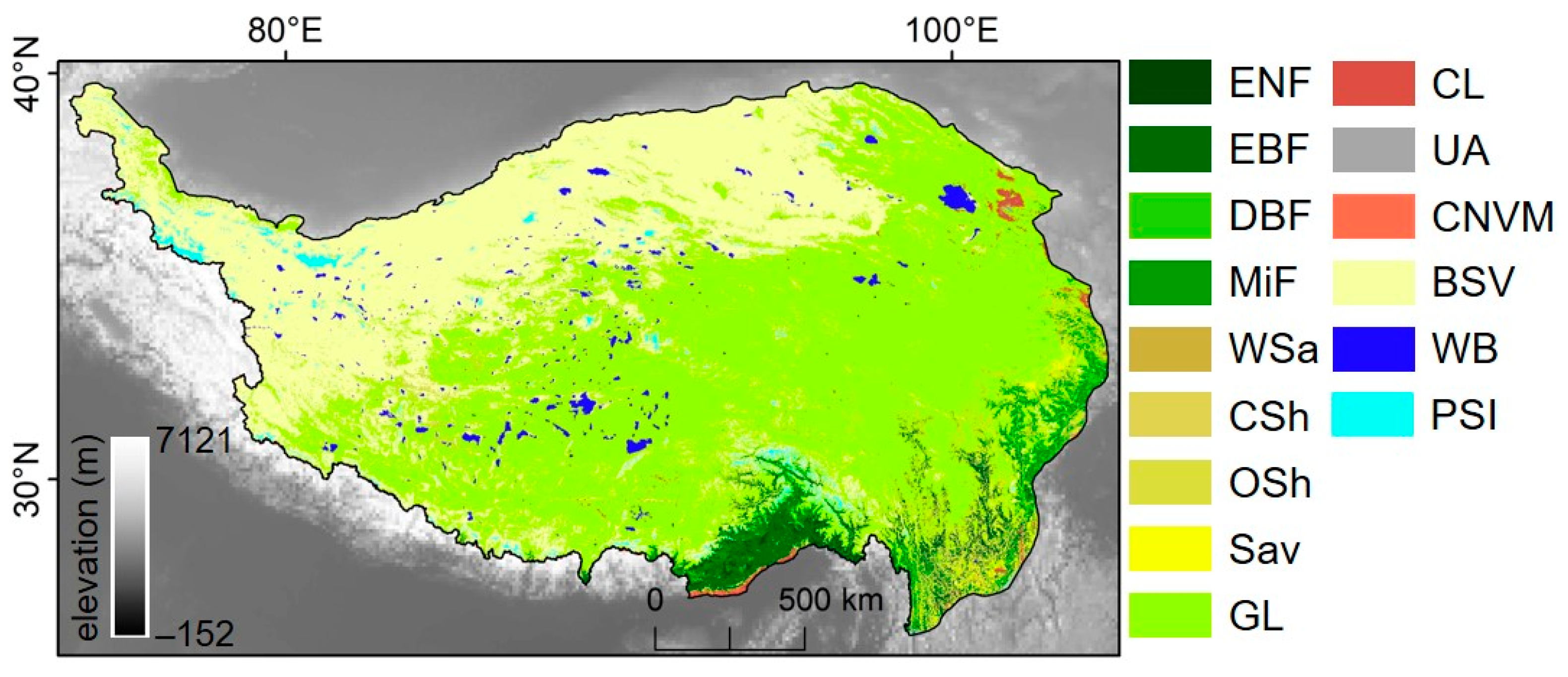
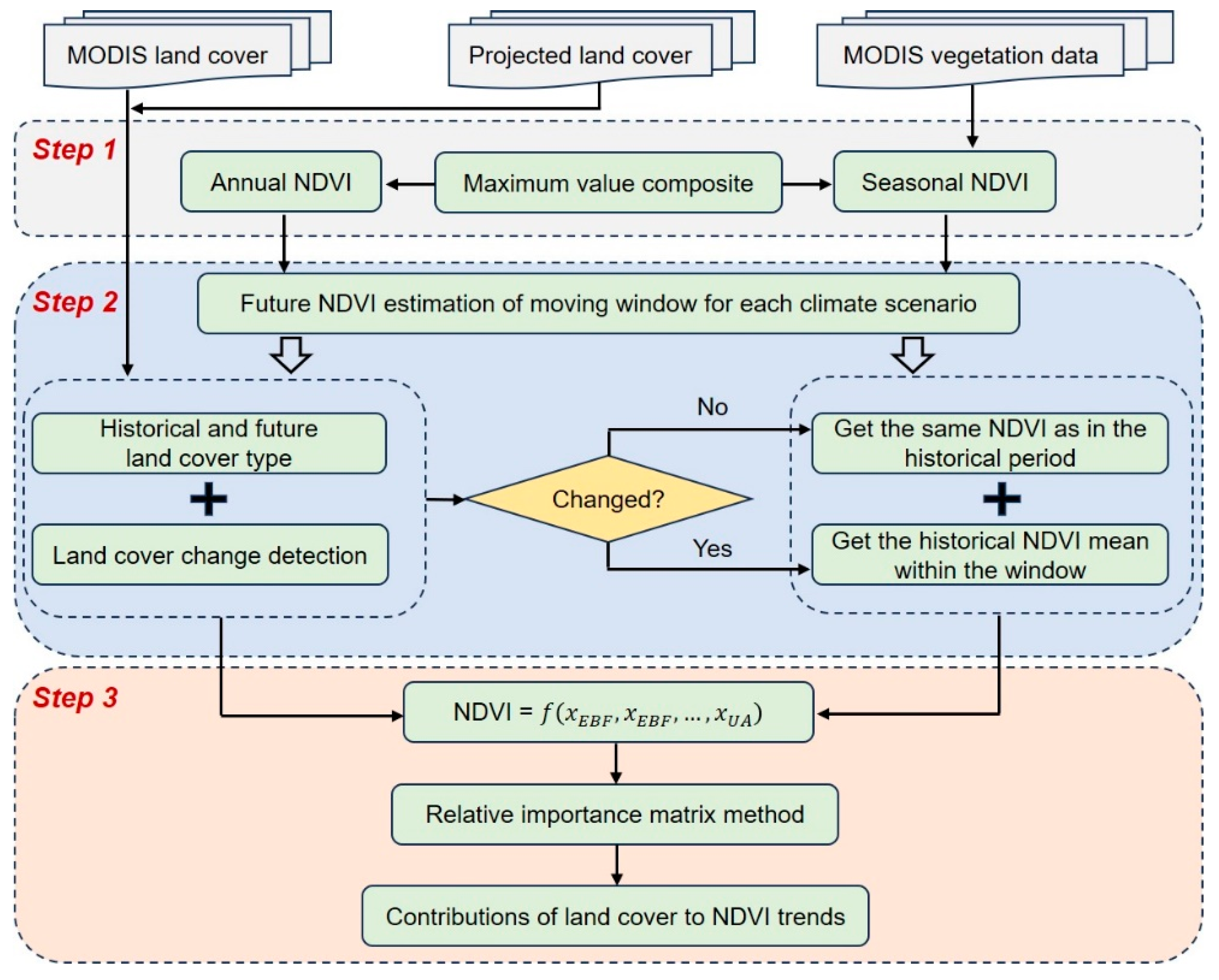
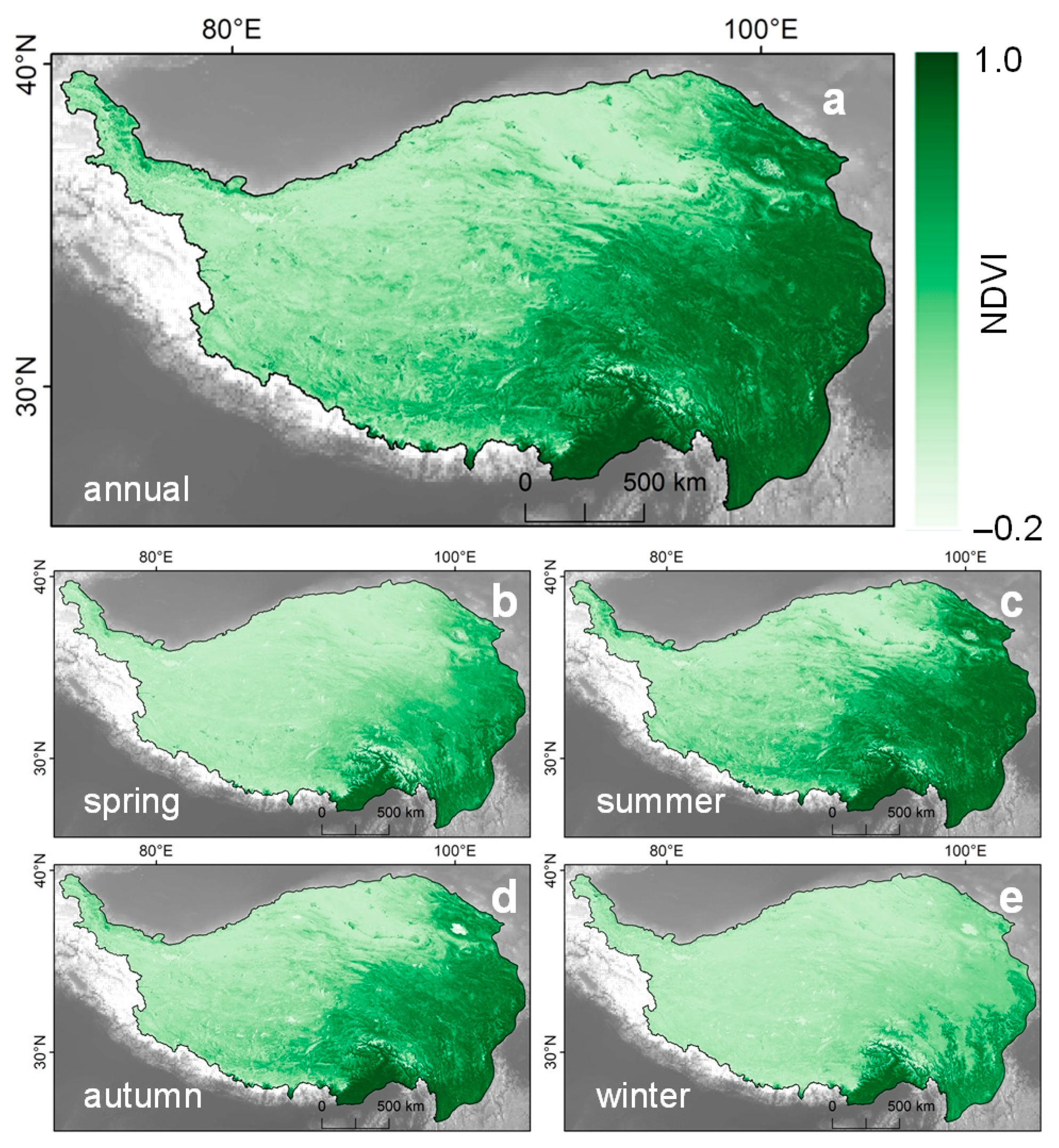

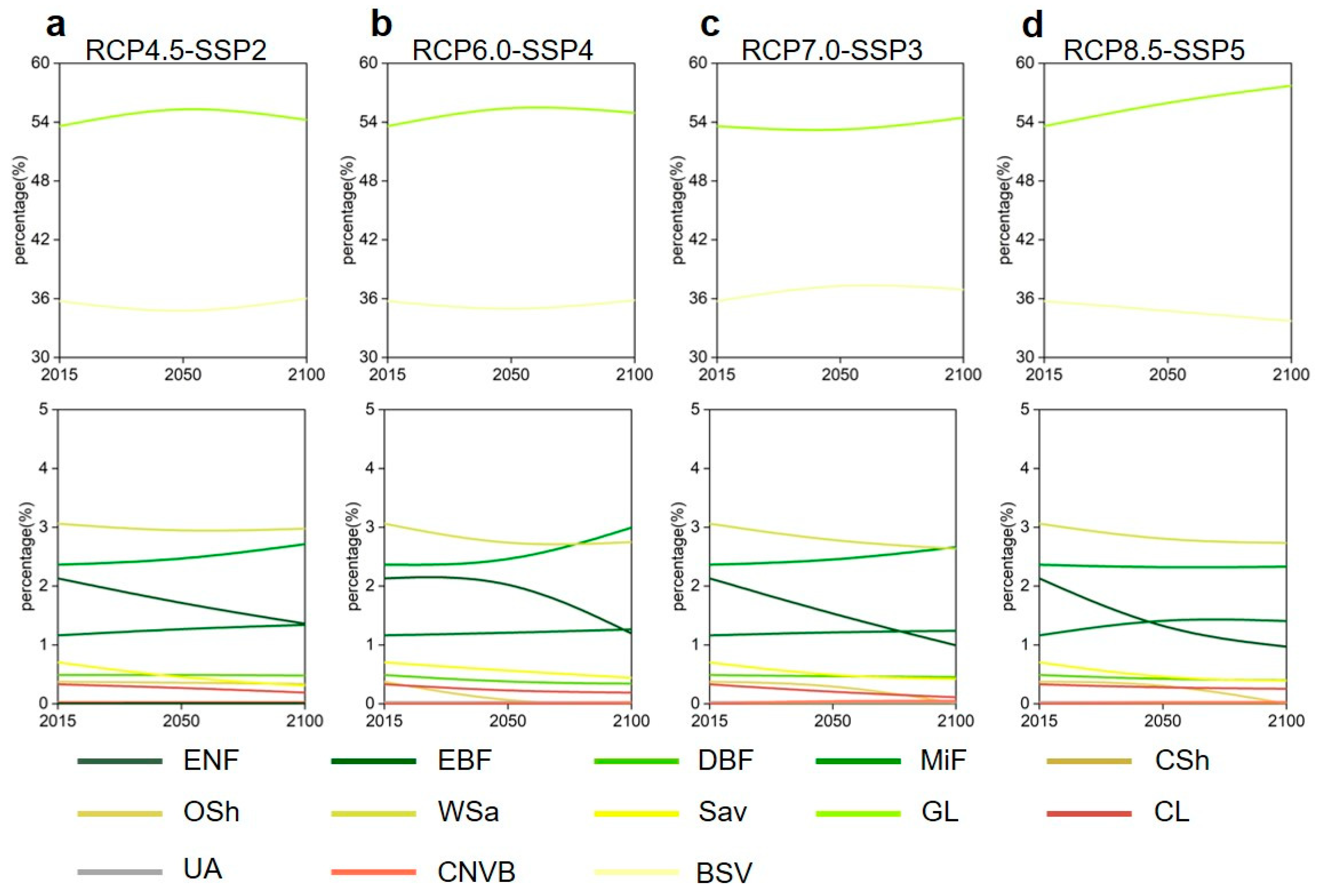
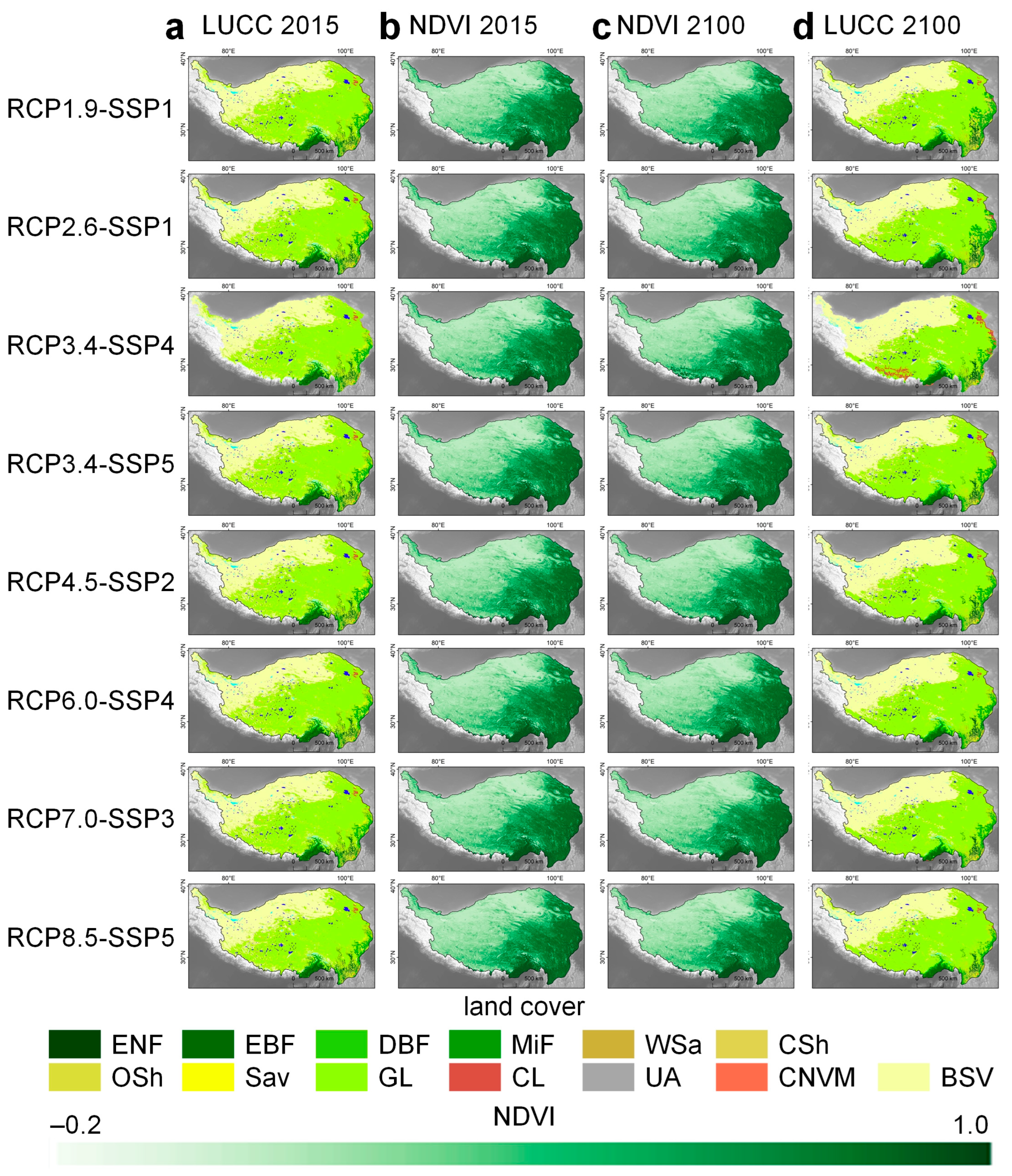

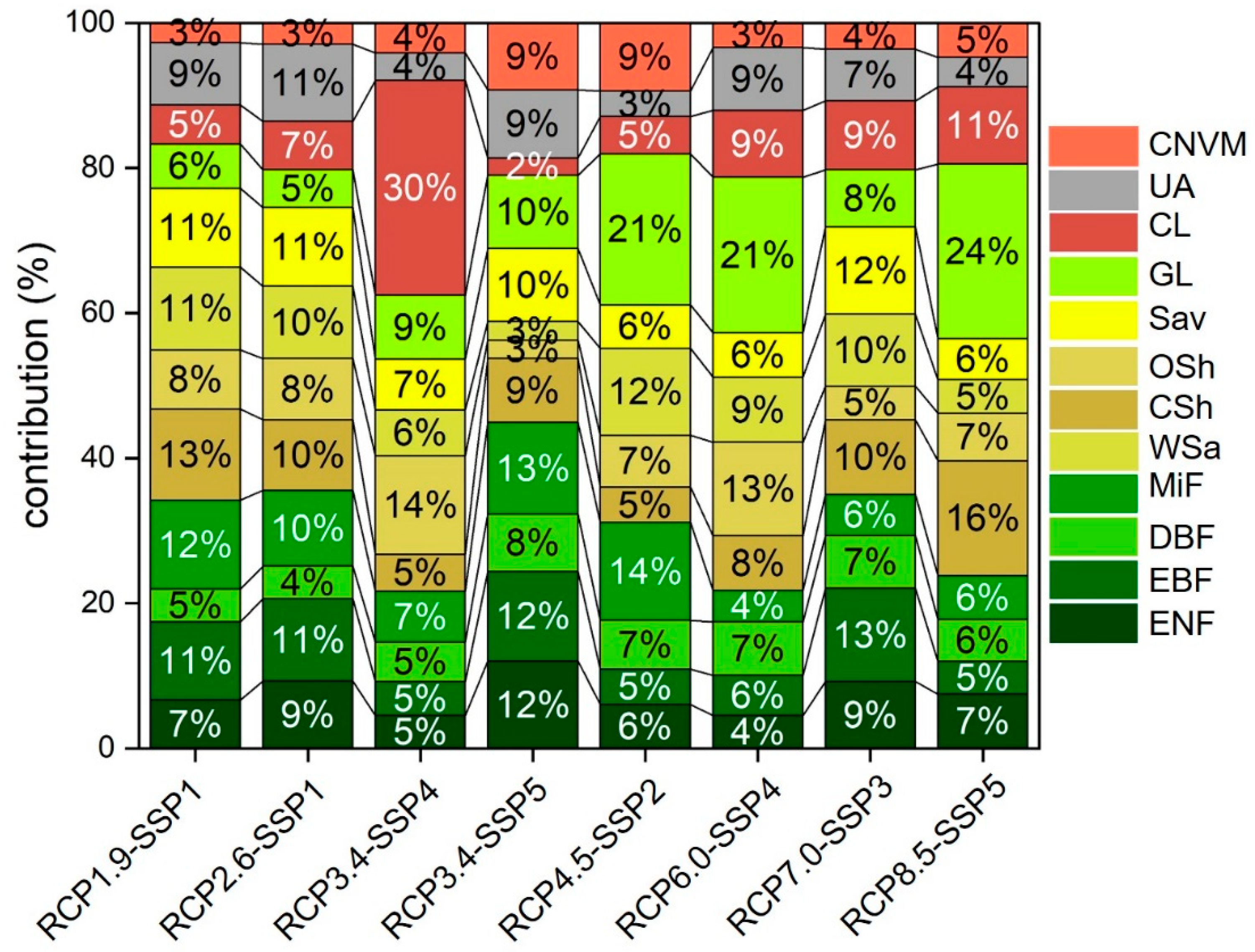
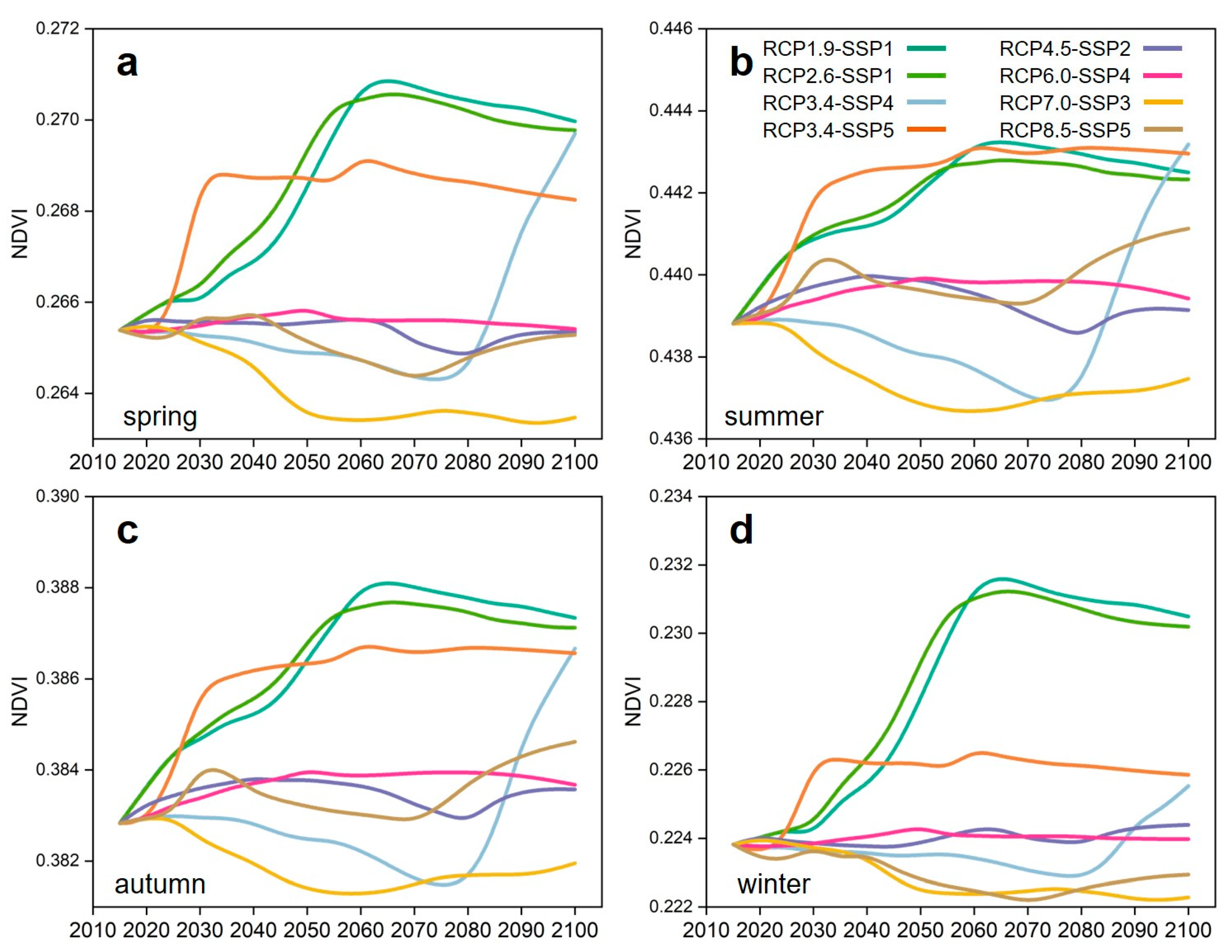
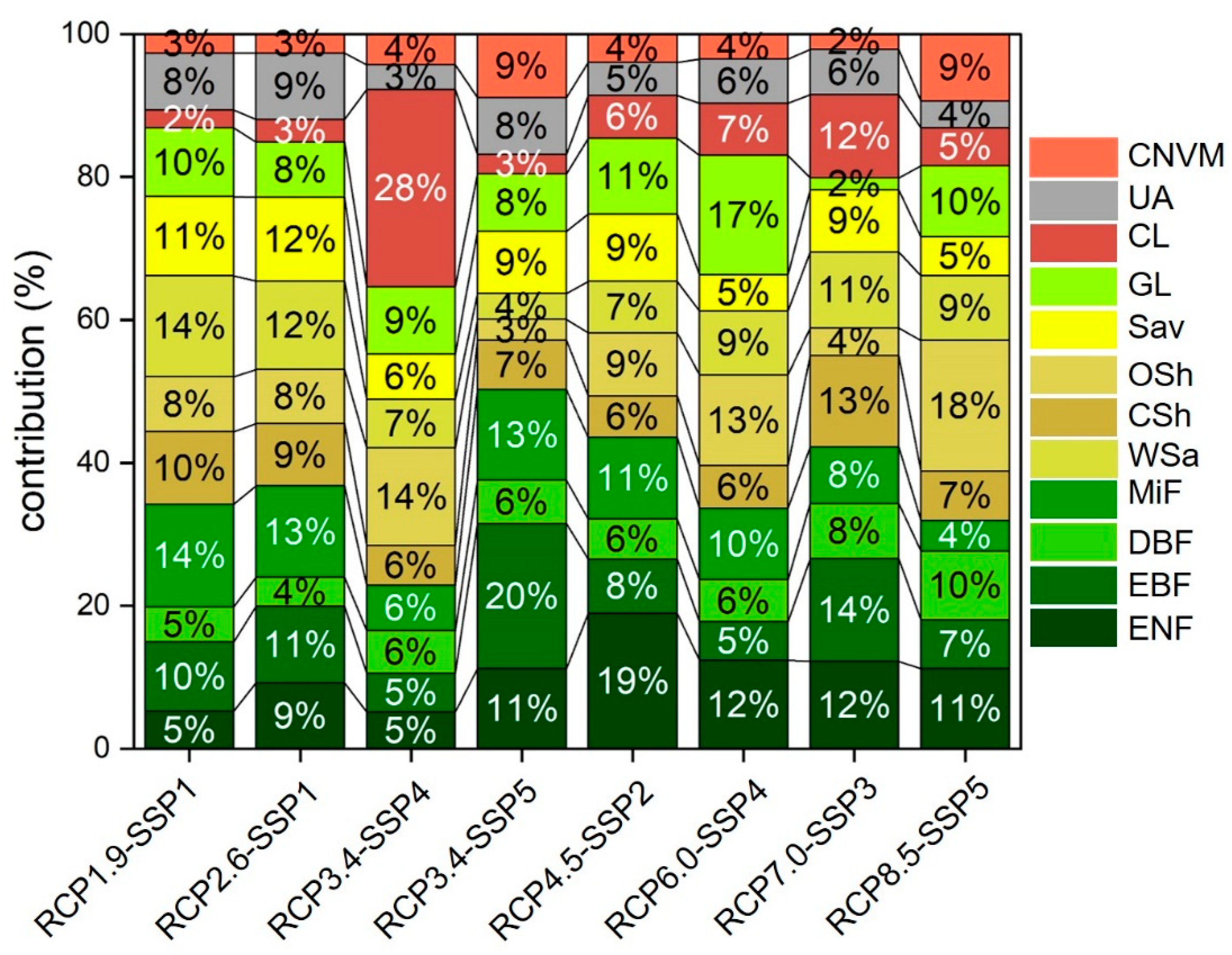
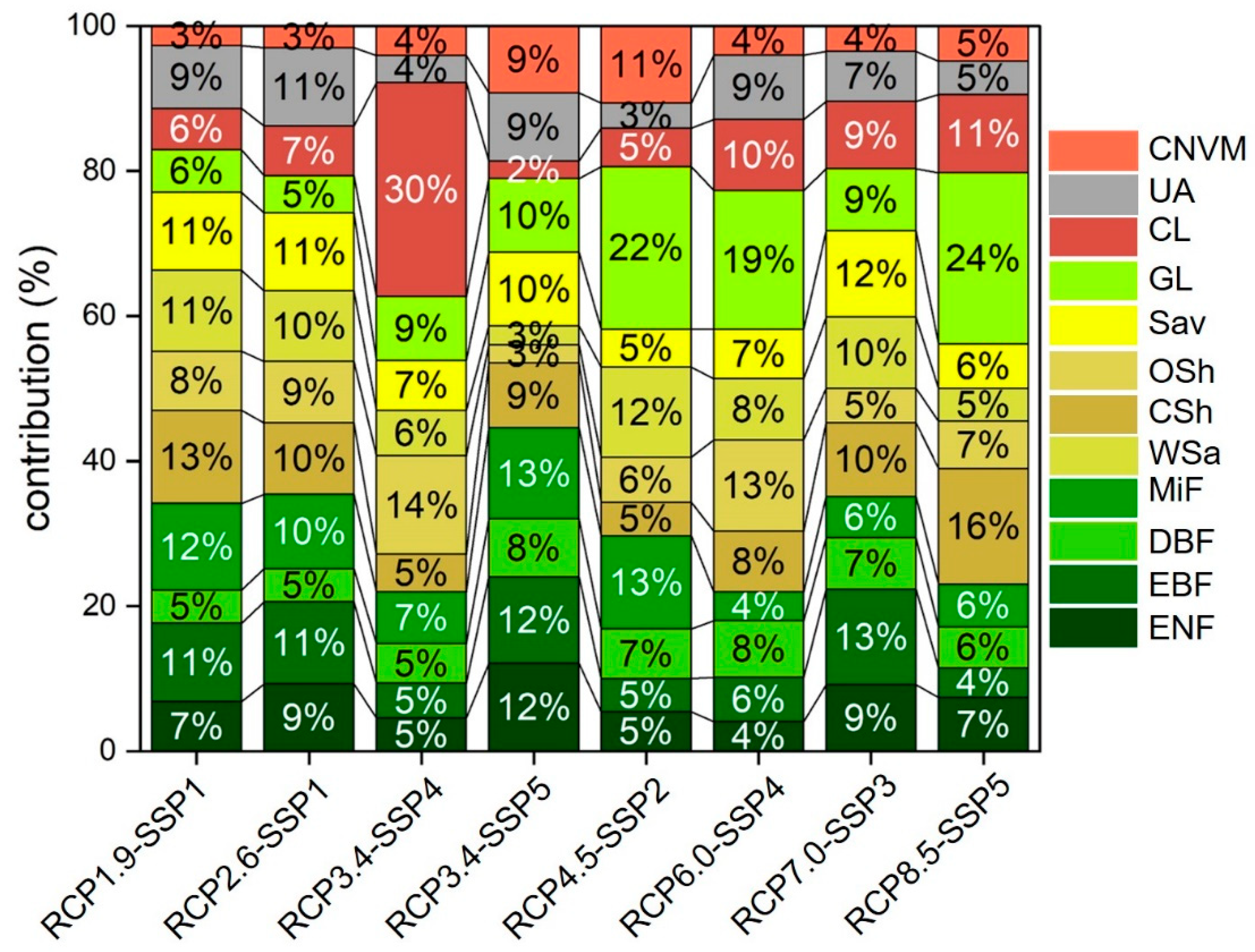


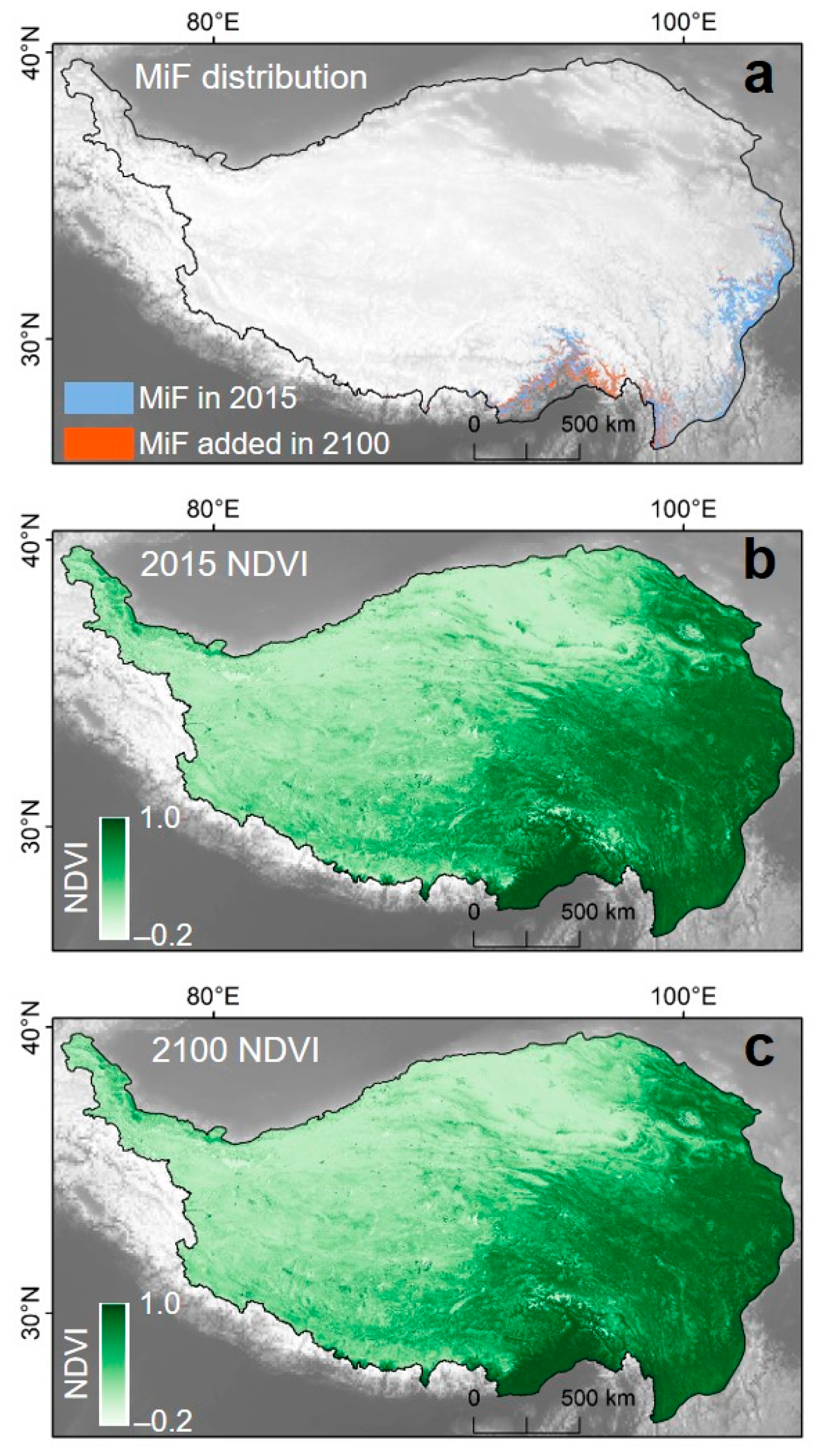
| Parameter | Dataset | Spatial Resolution | Temporal Resolution | Download Links |
|---|---|---|---|---|
| Land cover | MCD12Q1 | 500 m | Yearly | https://lpdaac.usgs.gov/products/mcd12q1v061, accessed on 1 December 2024 |
| Future land cover | Global IGBP LULC projection dataset under eight SSPs-RCPs | 1000 m | 5-year | https://doi.org/10.6084/m9.figshare.20088368.v1, accessed on 1 December 2024 |
| NDVI | MOD13A2 | 1000 m | 16 days | https://lpdaac.usgs.gov/products/mod13a2v061, accessed on 1 December 2024 |
| IGBP Code | IGBP Class | Broad Category |
|---|---|---|
| 1 | Evergreen Needleleaf Forest (ENF) | Forest |
| 2 | Evergreen Broadleaf Forest (EBF) | |
| 3 | Deciduous Needleleaf Forest (DNF) | |
| 4 | Deciduous Broadleaf Forest (DBF) | |
| 5 | Mixed Forest (MiF) | |
| 8 | Woody Savanna (WSa) | |
| 6 | Closed Shrubland (CSh) | Grassland |
| 7 | Open Shrubland (OSh) | |
| 9 | Savanna (Sav) | |
| 10 | Grassland (GL) | |
| 12 | Cropland (CL) | Agriculture |
| 14 | Cropland/Natural Vegetation Mosaic (CNVM) | |
| 13 | Urban and Built-up Land (UA) | Urban land |
| 16 | Barren or Sparsely Vegetated Land (BSV) | Barren land |
| 11 | Permanent Wetland | Ice and water |
| 15 | Snow and Ice | |
| 17 | Water Bodies |
| Climate Scenarios | Representative Concentration Pathways (RCPs) | Shared Socioeconomic Pathways (SSPs) |
|---|---|---|
| RCP1.9-SSP1 | Extremely low forcing scenario with radiative forcing stabilized at ~1.9 W/m2 in 2100 | Sustainability |
| RCP2.6-SSP1 | Low forcing scenario with radiative forcing stabilized at ~2.6 W/m2 in 2100 | Sustainability |
| RCP3.4-SSP4 | Low forcing scenario with radiative forcing stabilized at ~3.4 W/m2 in 2100 | Inequality |
| RCP3.4-SSP5 | Low forcing scenario with radiative forcing stabilized at ~3.4 W/m2 in 2100 | Fossil-fueled development |
| RCP4.5-SSP2 | Medium forcing scenario with radiative forcing stabilized at ~4.5 W/m2 in 2100 | Middle of the road |
| RCP6.0-SSP4 | Medium forcing scenario, with radiative forcing stabilized at ~5.4 W/m2 in 2100 and ~6.0 W/m2 after 2100 | Inequality |
| RCP7.0-SSP3 | Medium-to-high forcing scenario with radiative forcing stabilized at ~7.0 W/m2 in 2100 | Regional rivalry |
| RCP8.5-SSP5 | High forcing scenario with radiative forcing stabilized at ~6.0 W/m2 in 2100 | Fossil-fueled development |
| Climate Scenarios | ENF (%) | EBF (%) | DBF (%) | MiF (%) | WSa (%) |
|---|---|---|---|---|---|
| RCP8.5-SSP5 | −1.16 | 0.24 | −0.09 | −0.04 | −0.33 |
| RCP7.0-SSP3 | −1.14 | 0.08 | −0.03 | 0.30 | −0.43 |
| RCP6.0-SSP4 | −0.94 | 0.10 | −0.15 | 0.63 | −0.31 |
| RCP4.5-SSP2 | −0.77 | 0.18 | −0.01 | 0.35 | −0.08 |
| RCP3.4-SSP5 | −1.09 | 0.42 | −0.03 | 0.58 | −0.07 |
| RCP3.4-SSP4 | −0.27 | 0.05 | −0.22 | 0.10 | −0.90 |
| RCP2.6-SSP1 | −0.75 | 0.16 | −0.10 | 1.51 | 1.24 |
| RCP1.9-SSP1 | −0.53 | 0.14 | −0.06 | 1.25 | 1.42 |
Disclaimer/Publisher’s Note: The statements, opinions and data contained in all publications are solely those of the individual author(s) and contributor(s) and not of MDPI and/or the editor(s). MDPI and/or the editor(s) disclaim responsibility for any injury to people or property resulting from any ideas, methods, instructions or products referred to in the content. |
© 2024 by the authors. Licensee MDPI, Basel, Switzerland. This article is an open access article distributed under the terms and conditions of the Creative Commons Attribution (CC BY) license (https://creativecommons.org/licenses/by/4.0/).
Share and Cite
Wang, F.; Ma, Y. Vegetation Trends Due to Land Cover Changes on the Tibetan Plateau for 2015–2100 Largely Explained by Forest. Remote Sens. 2024, 16, 4558. https://doi.org/10.3390/rs16234558
Wang F, Ma Y. Vegetation Trends Due to Land Cover Changes on the Tibetan Plateau for 2015–2100 Largely Explained by Forest. Remote Sensing. 2024; 16(23):4558. https://doi.org/10.3390/rs16234558
Chicago/Turabian StyleWang, Fangfang, and Yaoming Ma. 2024. "Vegetation Trends Due to Land Cover Changes on the Tibetan Plateau for 2015–2100 Largely Explained by Forest" Remote Sensing 16, no. 23: 4558. https://doi.org/10.3390/rs16234558
APA StyleWang, F., & Ma, Y. (2024). Vegetation Trends Due to Land Cover Changes on the Tibetan Plateau for 2015–2100 Largely Explained by Forest. Remote Sensing, 16(23), 4558. https://doi.org/10.3390/rs16234558







